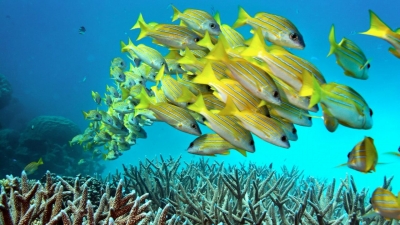
Stretching over 2,000 km in the Pacific Ocean along the coast of Queensland in Australia, it’s small wonder that the Great Barrier Reef is the largest living structure on Earth and home to the world’s largest coral reef. Visible even from Space, it comprises nearly 3,000 individual reefs in different shapes and sizes, in addition to several hundred islands nurturing a starting variety of plants and animals. In 1981, the region was included in UNESCO’s World Heritage List for its “outstanding natural universal values”.
Marine life
The Great Barrier Reef hosts over 400 types of coral, 1,500 species of fish, 5,000 types of molluscs, and 200 species of birds. Thanks to the extraordinary diversity in terms of habitats and species, the reef is one of the most complex natural ecosystems in the world. It is home to a staggering number of marine creatures. As if a fittibg underwater competitor to Africa’s Big Five, it houses the Great Eight – clown fish, sharks, manta rays, Maori wrasse, potato cod, giant clams, turtles, and whales. The reef is considered one of the best places to spot sea turtle species of the world are found here. The region holds scientific significance for being the habitat of the much threatened dugong (sea cow).
Did you know?
- Over the last few decades, global warming has resulted in coral bleaching in the Great Barrier Reef. An aerial survey revealed that back-to-back unprecedented coral bleaching in 2016 and 2017 affected nearly two-thirds of the corals, giving the damaged ones little chance to recover. In 2020, the region experienced what was reported as the “third mass coral bleaching event in five years”. However, some good news came in later.
- A survey was carried out in several parts of the region in 2020. Though most of the places were subject to various levels of bleaching, the overall bleaching was ascertained to be mild. The best news was that “many species were in recovery and mortality was extremely low”. The survey also conducted that “if conditions become more favouarble quickly there is a strong chance they will recover.
- There’s still a lot we do not know about the Great Barrier Reef, and it continues to awe and surprise us regularly. It did just that last year too. Explorers of the region discovered a giant pinnacle of coral taller than the Empire State Building in New York, the U.S. Considered the first such discovery in more than a century, the coral stood at 500 mt. For scale and comparison, the Empire State Building – one of the tallest buildings of the world – is not even 450 mt.
Picture Credit : Google



